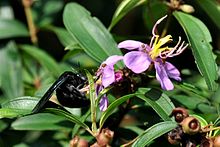Xylocopa nasalis
| Xylocopa nasalis | |
|---|---|
 |
|
| X. nasalis feeding on Singaporean rhododendron | |
| Scientific classification | |
| Kingdom: | Animalia |
| Phylum: | Arthropoda |
| Class: | Insecta |
| Order: | Hymenoptera |
| Family: | Apidae |
| Genus: | Xylocopa |
| Species: | X. nasalis |
| Binomial name | |
|
Xylocopa nasalis Westwood, 1838 |
|
| Synonyms | |
|
|
The Oriental carpenter bee, Xylocopa nasalis, or Xylocopa (Biluna) nasalis, is a species of carpenter bee. It is widely distributed in Southeast Asian countries. It is a major pollinator within its ecosystem, and is often mistaken for a bumblebee. The species leads a solitary lifestyle with a highly female-biased colony in the nest.
Xylocopa nasalis is a member of the Xylocopa genus, first described in 1802 by French entomologist Pierre André Latreille. The genus name is derived from Ancient Greek and translates to ¨wood-cutter.¨ Xylocopa is comprised specifically of carpenter bees, who build their nests in burrows in dead wood, bamboo, or structural timbers. The genus is also related to the genus of Ceratina, which are referred to as ¨small carpenter bees.”
Easily mistaken for bumble bees, carpenter bees of X. nasalis are relatively large, with a sturdy, black, lustrous body. Their thorax can exceed 5 mm in length, and some have yellow markings on their head.
The front wing marginal cell is thin and stretched, while the apex, the anterior corner of the wing, leans away from the costa, which is the leading edge of the wing. Moreover, the front wing also has small stigma cells. Short mandibles cover the labral flap of the bee when the mandibles are closed.
X. nasalis have compound eyes, which can consist of thousands of individual photoreceptor units. The image produced for this species of bees is a systematic collaboration of the numerous inputs received from the photoreceptors. These kinds of eyes can view in large angles and are able to detect rapid movement.
The eggs of X. nasalis are very large relative to the size of females and are known to be some of the largest eggs among all insects.
Males have a white or yellow face, while the females do not have these characteristics. Moreover, males often have much larger eyes than the females. Males do not contain a stinger, while the females are capable of using their stingers, but rarely do unless directly provoked or in immediate danger.
X. nasalis is a common carpenter bee found in Southeast Asia, predominantly in tropic and subtropic regions such as Thailand, Vietnam, West Malaysia, and Singapore.
...
Wikipedia
